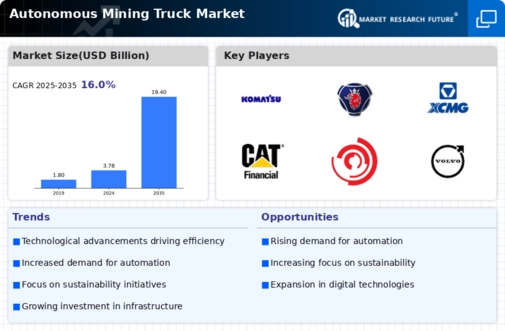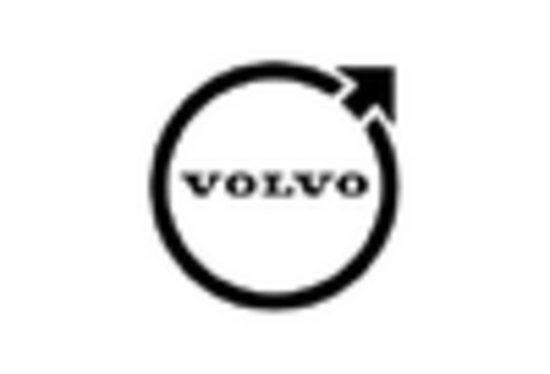The Autonomous Mining Truck Market is currently characterized by a dynamic competitive landscape, driven by technological advancements and a growing emphasis on operational efficiency. Major players such as Caterpillar Inc (US), Komatsu Ltd (JP), and Volvo Group (SE) are at the forefront, each adopting distinct strategies to enhance their market positioning. Caterpillar Inc (US) focuses on integrating advanced automation technologies into its fleet, aiming to improve safety and productivity. Meanwhile, Komatsu Ltd (JP) emphasizes sustainability, developing electric and hybrid models to reduce emissions and operational costs. Volvo Group (SE) is leveraging digital transformation, utilizing data analytics to optimize fleet management and maintenance schedules, thereby enhancing customer value. Collectively, these strategies not only foster innovation but also intensify competition within the market, as companies strive to differentiate themselves through technological prowess and sustainability initiatives.
In terms of business tactics, companies are increasingly localizing manufacturing to reduce costs and enhance supply chain resilience. This approach is particularly relevant in the context of geopolitical uncertainties and fluctuating global supply chains. The market structure appears moderately fragmented, with several key players holding substantial market shares while also facing competition from emerging firms. The collective influence of these established companies shapes the market dynamics, as they set benchmarks for technology and service standards that smaller players must strive to meet.
In August 2025, Caterpillar Inc (US) announced a strategic partnership with a leading AI firm to enhance its autonomous truck navigation systems. This collaboration aims to integrate machine learning algorithms that could potentially improve route optimization and operational efficiency. The significance of this move lies in its potential to position Caterpillar as a leader in AI-driven mining solutions, thereby attracting clients seeking cutting-edge technology to enhance productivity.
In September 2025, Komatsu Ltd (JP) unveiled its latest electric autonomous mining truck, which is designed to operate in harsh environments while minimizing environmental impact. This launch underscores Komatsu's commitment to sustainability and innovation, as it seeks to capture a growing segment of environmentally conscious clients. The strategic importance of this development is evident, as it not only aligns with global sustainability trends but also enhances Komatsu's competitive edge in a market increasingly focused on reducing carbon footprints.
In October 2025, Volvo Group (SE) expanded its digital services portfolio by introducing a new predictive maintenance platform for its autonomous trucks. This platform utilizes real-time data analytics to forecast maintenance needs, thereby reducing downtime and operational costs for clients. The strategic relevance of this initiative is profound, as it positions Volvo as a pioneer in leveraging digital solutions to enhance operational efficiency, which is becoming a critical factor in client decision-making processes.
As of October 2025, the Autonomous Mining Truck Market is witnessing a pronounced shift towards digitalization, sustainability, and AI integration. These trends are reshaping competitive dynamics, as companies increasingly form strategic alliances to enhance their technological capabilities and market reach. The evolution of competition appears to be moving away from traditional price-based strategies towards a focus on innovation, technological advancement, and supply chain reliability. This shift suggests that future competitive differentiation will hinge on the ability to deliver superior technological solutions and sustainable practices, thereby meeting the evolving demands of the mining industry.


















Leave a Comment